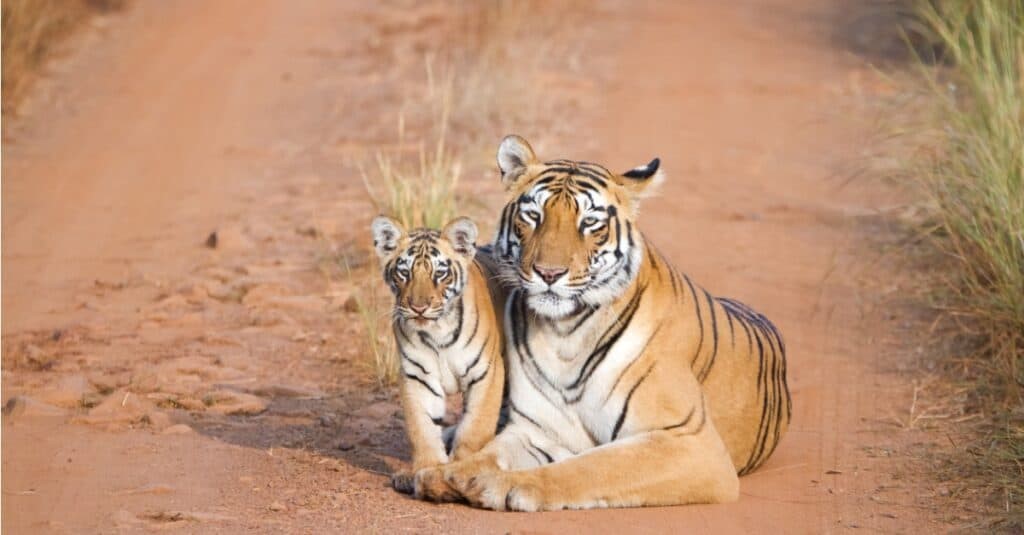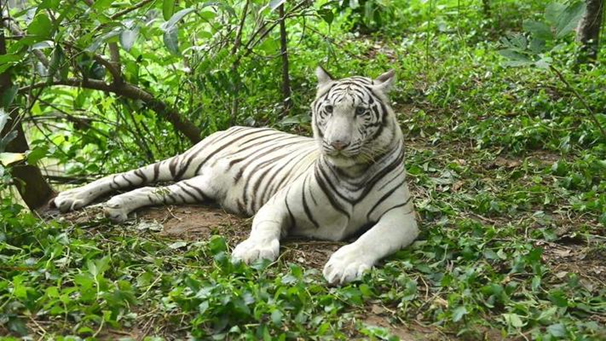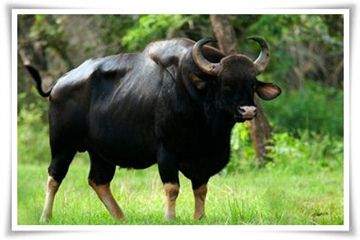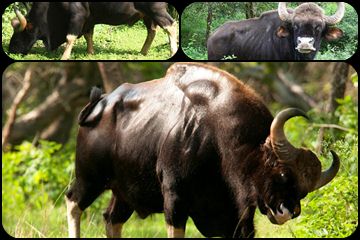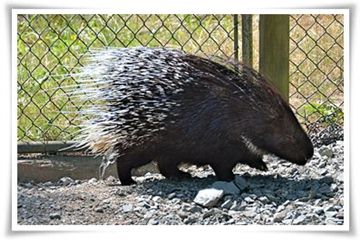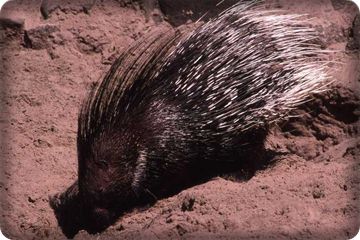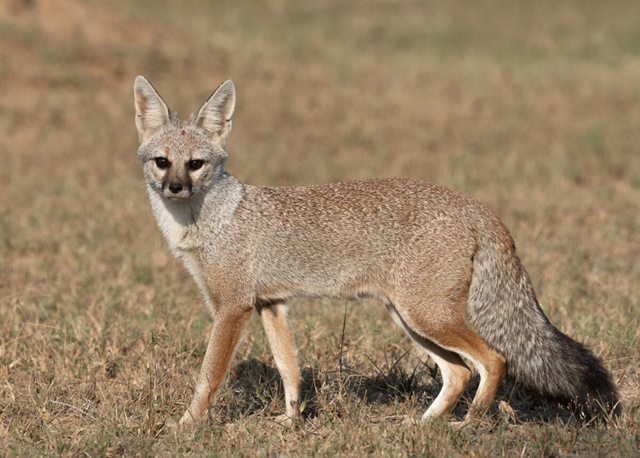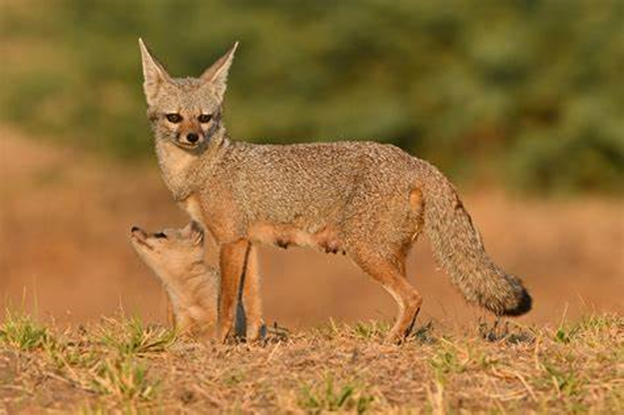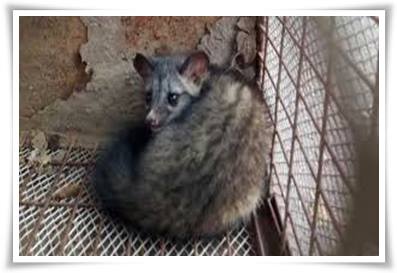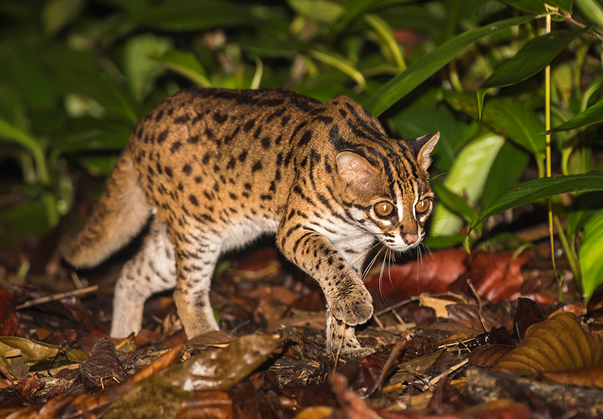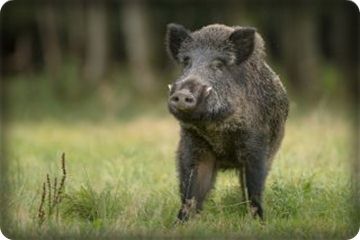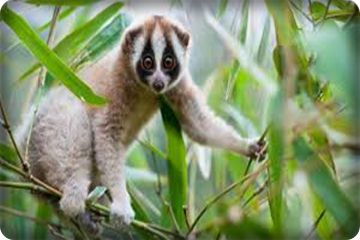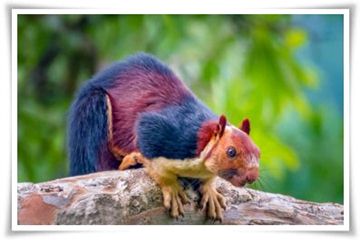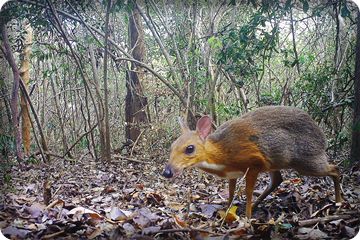- Kingdom - Animalia
- Phylum - Chordata
- Class - Mammalia
- Order - Carnivora
- Family - Felidae
- Genus - Panthera
- Species - Panthera tigris tigris
- English Name: Bengal Tiger
- Scientific Name: Panthera tigris tigris
- Distribution:India, Pakistan, Nepal, Bangladesh, Bhutan, China
- General Description :
The Bengal tiger (Panthera tigris tigris) is the nominate Tiger subspecies. It ranks among the biggest wild cats alive today. It is considered to belong to the world's charismatic megafauna. The Bengal tiger is estimated to have been present in the Indian subcontinent since the Late Pleistocene, for about 12,000 to 16,500 years. Today, it is threatened by a number of threats caused by humans.
- Weight: 80-260 kg
- Length: 255-311 cm
- Height: 90-110 cm
- Food in Zoo: Beef, Mutton, Chicken, Milk.
- Sexual Maturity: 4 – 5 years.
- Gestation Period:104-106 days.
- Average Life Span: 10-26 years
- Conservation Status: Endangered
- CITES: Appendix – I
- WPA 1972: Schedule I
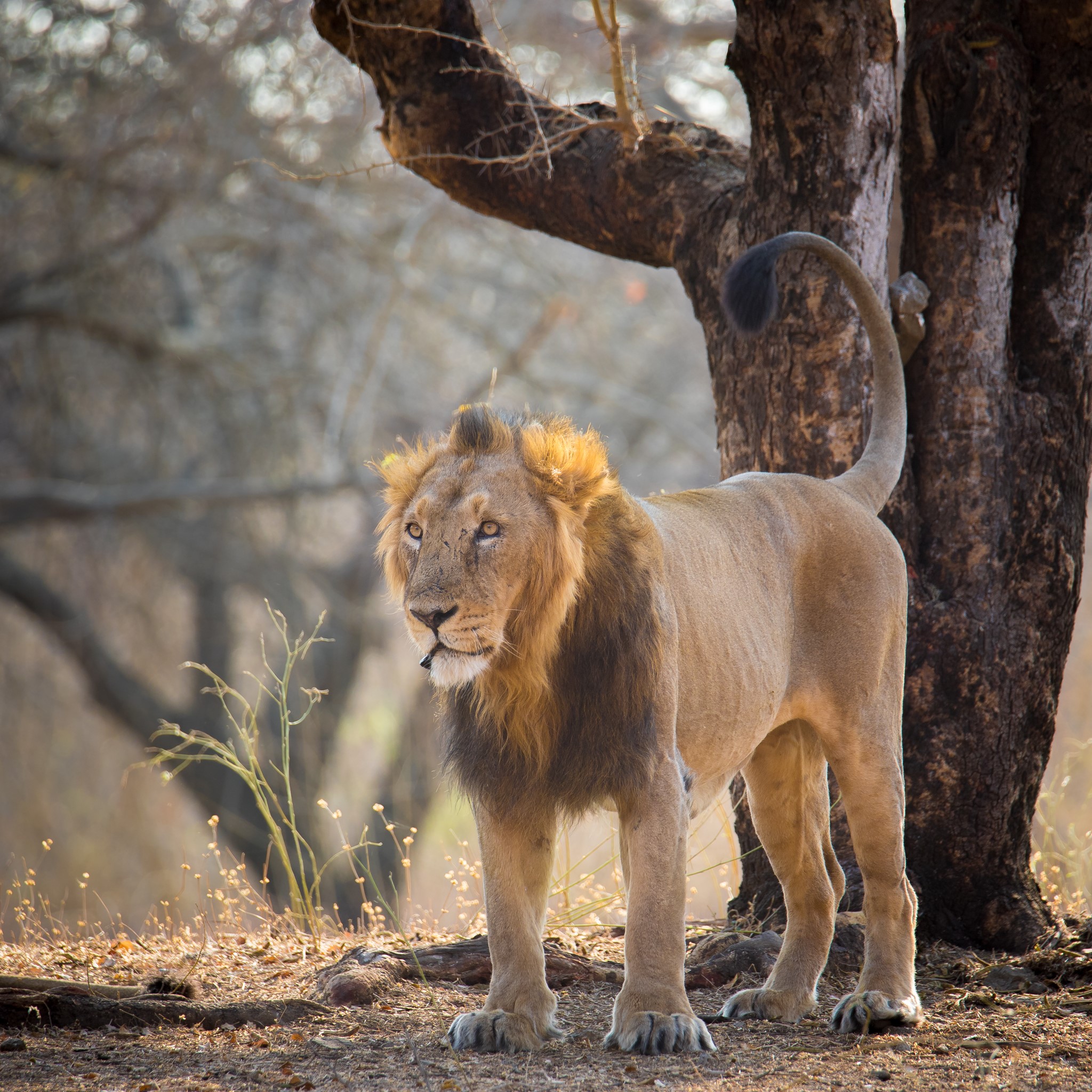

- Kingdom - Animalia
- Phylum - Chordata
- Class - Mammalia
- Order - Carnivora
- Family - Felidae
- Genus - Panthera
- Species - Panthera leo persica
- English Name: Asiatic Lion
- Common Name:Asiatic Lion
- Scientific Name: Panthera leo persica.
- Distribution:The Gir Forest in Gujarat (India) is the major area of Asian lions’ distribution. In fact, the Wildlife Sanctuary (Western Gujarat) and the dry deciduous forest of Gir National Park is currently the only habitat for these animals.
- General Description :
The Asiatic lion is a population of Panthera leo leo that today survives in the wild only in India. Until the 19th century, it occurred in Saudi Arabia, eastern Turkey, Iran, Mesopotamia, Pakistan, and from east of the Indus River to Bengal and the Narmada River in Central India.
- Size:Male Asiatic Lion reach up to 1.7-2.5 metres in length. Female lions reach up to 1.5-1.9 metres in length.
- Weight:Male Asiatic lion reach weights of 160 – 190 kilograms .The female Asiatic lion weigh 110 – 120 kilograms
- Food in Zoo: Buffalo meat (boneless).
- Sexual Maturity: 5 years.
- Pregnancy Period 109 days.
- Average Life Span:30 years.
- Conservation Status: Endangered
- CITES: Appendix – I
- WPA 1972: Schedule I
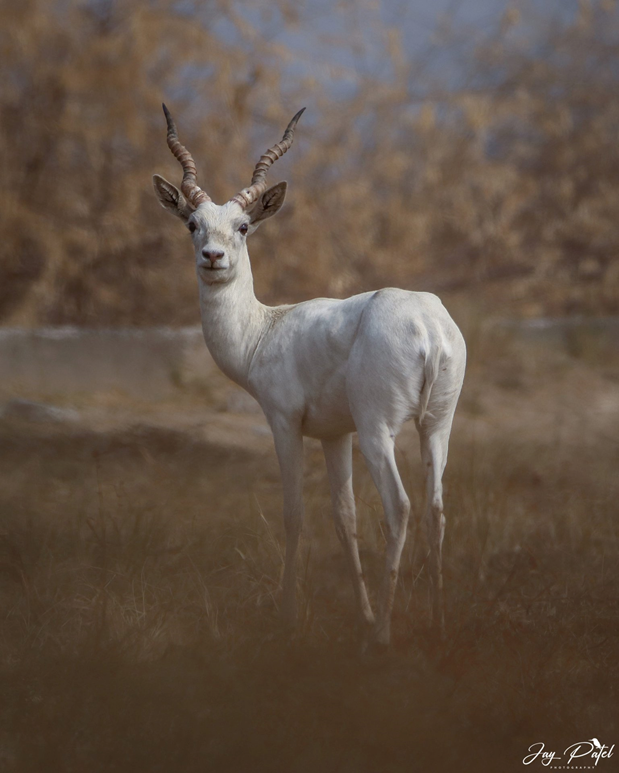
- Kingdom - Animalia
- Phylum - Chordata
- Class - Mammalia
- Order - Artiodactyla
- Family - Bovidae
- Genus - Antilope
- Species - Antilope cervicapra
- English Name: Blackbuck
- Common Name:Antilope cervicapra
- Scientific Name: Panthera leo persica.
- Distribution:The main area of their habitat is India and eastern Pakistan. They live in grassy plains and thinly forested areas where perennial water sources are available for their daily need to drink.
- General Description :
Blackbucks have slender and elegant bodies. They have pointed and delicate hooves. They possess narrow, sheep-like muzzles and short tails. Horns are found only in males. The coloration of this species depends on gender: the back, the sides, and the outer side of the legs are rich dark brown in males and yellowish in females.
- Size:120-150 cm
- Weight:: Male: 34-45 kg, Female: 31-39 kg
- Food in Zoo: Spinach, grass and leaves, soya meal, mahua, bird mesh
- Sexual Maturity: Male: 3 years, Female: 2 years.
- Pregnancy Period 6 months
- Average Life Span:15-18 years
- Conservation Status: Near threatened
- CITES: Appendix – III
- WPA 1972: Schedule I
- Kingdom - Animalia
- Phylum - Chordata
- Class - Mammalia
- Order - Carnivora
- Family - Felidae
- Genus - Panthera
- Species - Panthera tigris tigris
- English Name: Leucistic Bengal Tiger
li>Scientific Name: Panthera tigris tigris.
- Distribution:India, Pakistan, Nepal, Bangladesh, Bhutan, China
- General Description :
White tiger, colour variant of the Bengal tiger (Pantheria tigris tigris), the Siberian tiger (P. tigris altaica), or a hybrid between the two subspecies that is characterized by white fur, dark brown or black stripes, and blue eyes. This rare colour mutation, called leucism, which also occurs in many other animals, appears in perhaps one in 10,000 tigers in the wild.
- Size:Length: 255-311 cm, Height: 90-110 cm
- Weight:80-260 kg
- Food in Zoo: Buffalo meat (boneless).
- Sexual Maturity:4- 5 years.
- Pregnancy Period 104-106 days.
- Average Life Span:10-26 years.
- Conservation Status: Endangered
- CITES: Appendix – I
- WPA 1972: Schedule I
- Kingdom - Animalia
- Phylum - Chordata
- Class - Mammalia
- Order - Carnivora
- Family - Felidae
- Genus - Panthera
- Species - Panthera pardus
- English Name: Common Leopard
- Scientific Name:Panthera pardus
- Distribution:India, Pakistan, Nepal, Bangladesh, Bhutan, China
- General Description :
The leopard (Panthera pardus) is one of the five extant species in the genus Panthera, a member of the cat family, Felidae. The leopard is distinguished by its well-camouflaged fur, opportunistic hunting behaviour, broad diet, strength, and its ability to adapt to a variety of habitats ranging from rainforest to steppe, including arid and montane areas.
- Length: 90-190 cm
- Height:57-70 cm
- Weight: Male Leopard reach weights of 45 – 77 kilograms . • The female leopard weighs 30 – 45 kilograms.
- Food in Zoo: Buffalo meat (boneless).
- Sexual Maturity: 2.5 years
- Gestation Period: 97 days.
- Average Life Span: 21-23 years
- Conservation Status: Endangered
- CITES: Appendix – I
- WPA 1972: Schedule I

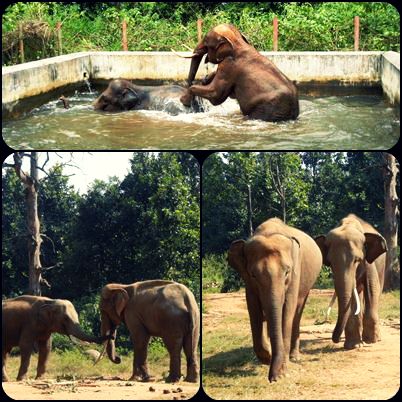
- Kingdom - Animalia
- Phylum - Chordata
- Class - Mammalia
- Order - Proboscidea
- Family - Elephantidae
- Genus - Elephas
- Species - Elephas maximus
- English Name: Asian Elephant
- Scientific Name:Elephas maximus
- Distribution:The range extended as far west as current day Iraq, as far north as the Yangtze River in China, and across the Indian subcontinent and Southeast Asia, including the islands of Sri Lanka and Sumatra (Indonesia)
- General Description :
The Asian elephant (Elephas maximus) is one of only three living species of elephants or elephantids anywhere in the world, the others being the African bush elephant and African forest elephant. The Asian elephant is the largest living land animal in Asia.
- Size:Body length: 5.5-5.6 m, height: 2.4-2.8 m
- Weight: Male: 3200-5400 kg, Female: 3000-3300 kg
- Food in Zoo: Boiled Rice, Chickpeas, Jaggery, Ripe Banana, watermelon, grass, branches and leaves, sugarcane
- Gestation Period: 21 months
- Average Life Span: 60-70 years
- Conservation Status: WP Act (1972) – Schedule I, IUCN RedList – Endangered
- CITES: Appendix – I
- WPA 1972 Schedule I
- Kingdom - Animalia
- Phylum - Chordata
- Class - Mammalia
- Order - Artiodactyla
- Family - Bovidae
- Genus - Bos
- Species - Bos gaurus
- English Name: Indian Bison
- Scientific Name:Bos gaurus
- English Name: Bison
- Common Name:Bison
- Scientific Name: Bos gaurus.
- Distribution:The range of Bos frontalis is Nepal, India to Indochina, and the Malay Peninsula.
- General Description :
Being one of the largest cattle species, the gaur has a massive head, deep body, and solid limbs.Both males and females have upwardly curved horns, growing from the sides of their heads. Their horns have a yellow base and black tip.
- Size:Body length: 250-330 cm, height: 165-220 cm
- Weight: 650-1000 kg
- Food in Zoo: Wheat bran, almond straw, oat bran, chickpea, common salt, grasses and leaves, Kutti.
- Sexual Maturity: 3 years.
- Gestation Period: 283 days.
- Average Life Span: About 26 years.
- Conservation Status: WP Act (1972)- Schedule -I, IUCN RedList-Vulnerable.
- CITES: Appendix – I

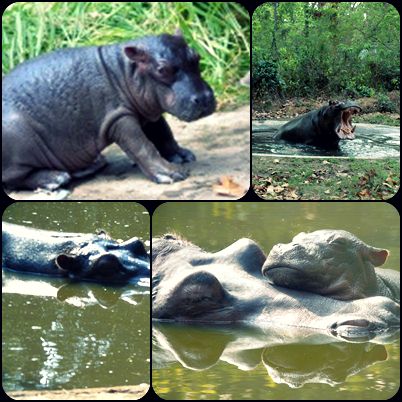
- Kingdom - Animalia
- Phylum - Chordata
- Class - Mammalia
- Order - Artiodactyla
- Family - Hippopotamida
- Genus - Hippopotamus
- Species - Hippopotamus amphibius
- English Name: Hippopotamus
- Scientific Name:Hippopotamus amphibius
- Distribution:Hippopotamus (Hippopotamus amphibius) are found exclusively in the Ethiopian region of the world. Hippos occur in rivers throughout the savanna of Africa and the main rivers of Central Africa.
- General Description :
: Hippos are recognizable for their barrel-shaped torsos, wide-opening mouths with large canine tusks, nearly hairless bodies, pillar-like legs, and large size. The eyes, ears, and nostrils of hippos are placed high on the roof of their skulls. This allows these organs to remain above the surface while the rest of the body is submerged.
- Body length: 200-505 cm
- height:200 cm
- Weight: 1300-4500 kg
- Food in Zoo: Pudding, Ripe Banana, Slice Bread, Honey, Cabbage, Egg
- Sexual Maturity: 1-2 Years
- Pregnancy Period:108-120 Days
- Conservation Status:
- IUCN:Vulnerable
- CITES:Appendix I
- WPA 1972:NA

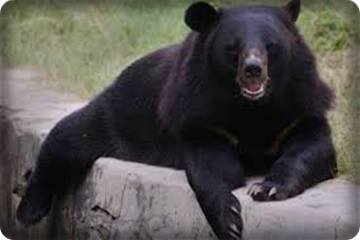
- Kingdom - Animalia
- Phylum - Chordata
- Class - Mammalia
- Order - Carnivora
- Family - Ursidae
- Genus - Ursus
- Species - Ursus thibetanus
- English Name: : Asiatic Black Bear
- Scientific Name:Ursus thibetanus
- Distribution:Ursus thibetanus is widely distributed. Asiatic black bears can be found north of Pakistan, south of Afghanistan, east of the Himalayans, north of Vietnam, south of China, and in Thailand.
- General Description :
The Asiatic black bear is a bear of medium to large size with a large rounded head and small eyes. Its body is heavy, and its legs are strong and thick with broad paws. It walks on the soles of its feet, as humans do. It has a short tail that can hardly be seen under its long, coarse coat.
- Size: 120-190 cm, height:70-130 cm
- Weight: Male: 60-250 kg, Female: 35-170 kg
- Food in Zoo: Milk, Ripe Banana, Slice Bread, Cabbage/ Carrot/ Cucumber
- Sexual Maturity: 3-4 Years
- Gestation Period: 7-8 months
- Average Life Span: 25-33 years
- Conservation Status: :Vulnerable.
- CITES: Appendix – I
- WPA 1972: Schedule II
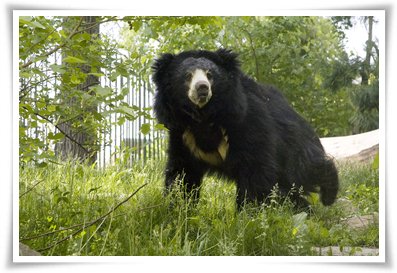
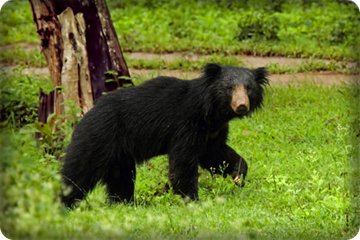
- Kingdom - Animalia
- Phylum - Chordata
- Class - Mammalia
- Order - Carnivora
- Family - Ursidae
- Genus - Ursus
- Species - Ursus thibetanus
- English Name: : Asiatic Black Bear
- Scientific Name:Ursus thibetanus
- Distribution: low hills bordering the outer range of the Himalayas from Punjab to Arunachal Pradesh.
- General Description :
Sloth bears have shaggy, dusty-black coats; pale, short-haired muzzles; and long, curved claws which they use to excavate termites and ants. Sloth bears’ nostrils can close completely, protecting the animals from dust or insects when raiding termite nests or beehives.
- Size: Sloth bears grow 5 to 6 feet (1.5 to 2 meters) long, stand 2 to 3 feet (0.5 to 1 meters) high at the shoulder.
- Weight: Male 180 – 230 kg. Female about 165 kgweigh, on average, 200 to 300 pounds (90 to 140 kilograms).
- Food in Zoo:Honey,Milk, Rice, Jaggery,Ripe Banana, Green Maize, sweet Potato etc.
- Sexual Maturity: 2 to 3 years.
- Gestation Period: 4 to 7 months.
- Average Life Span: 40 years
- Conservation Status: WP Act (1972)- Schedule – I,It is listed as Vulnerable on the IUCN Red List,
- CITES: Appendix – I
- Reason: mainly because of habitat loss and degradation.
- Kingdom - Animalia
- Phylum - Chordata
- Class - Mammalia
- Order - Carnivora
- Family - Felidae
- Genus - Felis
- Species - Felis chaus
- English Name: Jungle Cat
- Scientific Name:Felis chaus
- Distribution:The Himalayas and north east India. Also found in South India, peninsular India and North India
- General Description :
The Jungle cat (Felis chaus) is a medium-sized cat. Its name comes from the Caucasus Mountains, the place this cat was first discovered. In Asia, it is the Jungle cat, but in Africa.
- Size: Male:Male jungle cats reach up to 0.6-0.85 metres in length. Female:Female reach up to 0.2-0.3 metres in length.
- Weight: Male – 5-12 kilograms, Female -2.5-9 kilograms
- Food in Zoo: Buffalo meat (boneless), Chicken
- Sexual Maturity: 11-18 months
- Gestation Period: 63-66 days.
- Average Life Span: 15-20 years
- Conservation Status: IUCN:Lower Risk
- CITES: Appendix – II
- WPA 1972:Schedule II
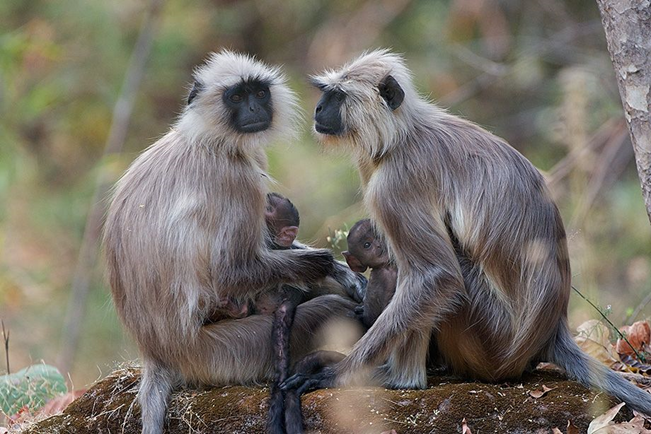

- Kingdom - Animalia
- Phylum - Chordata
- Class - Mammalia
- Order - Primates
- Family - Cercopithecidae
- Genus - Semnopithecus
- Species -Semnopithecus entellus
- English Name: Hanuman Langur
- Scientific Name:Semnopithecus entellus
- Distribution:The geographic range of Semnopithecus entellus (Hanuman langur) spans from Kashmir in north India and the Himalayas in Nepal, Bhutan, and Tibet south to Sri Lanka, east to Bangladesh and west to the Indus valley in Pakistan.
- General Description :
Hanuman langurs have brownish gray fur, with a tinge of red on their dorsal surface and white fur on their ventral surface. Their feet, hands, face, and ears are black, and their face is framed with white fur.
- Size: Body length: 55-75 cm, Tail length: 69-97 cm
- Weight: 9-11 kg
- Food in Zoo: Rice, ripe banana, guava, peanut, carrot/ brinjal, cabbage, chickpea
- Sexual Maturity: 2.5-7 Years
- Gestation Period: 200-212 days
- Average Life Span:18-30 years
- Conservation Status:
- IUCN RedList – Least Concerned
- CITES: Appendix – I
- WPA 1972: Schedule II

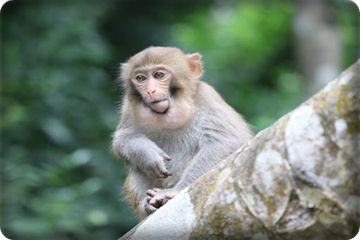
- Kingdom - Animalia
- Phylum - Chordata
- Class - Mammalia
- Order - Primates
- Family - Cercopithecidae
- Genus - Macaca
- Species -Macaca mulatta
- English Name: Rhesus macaque
- Scientific Name:Macaca mulatta
- Distribution:Populations of rhesus monkeys (Macaca mulatta) are most commonly found in western Afghanistan, through India to northern Thailand. This species was abundant historically in southern China and Tibet, but humans have caused drastic decline of populations in these areas over the last sixty years.
- General Description :
Rhesus macaques are either pale brown or gray, usually with pink faces. Their tails are quite long, they have a rib cage that is wider than average, with dorsal scapulae.
- Size:Body length: 47-63 cm, Tail length: 18-30 cm
- Weight: 5.3-7.7 kg
- Food in Zoo: Rice, ripe banana, guava, peanut, carrot/ brinjal, cabbage, chickpea
- Sexual Maturity:2.5-7 Years
- Gestation Period: 165 days
- Average Life Span: 30-35 years
- Conservation Status :Included in Schedule II of the wildlife (Protection) Act 1972. IUCN RedList- Least Concern
- CITES:Appendix -II
- WPA 1972:Schedule II

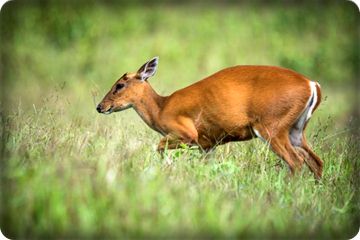
- Kingdom - Animalia
- Phylum - Chordata
- Class - Mammalia
- Order - Artiodactyla
- Family - Cervidae
- Genus - Muntiacus
- Species -Muntiacus muntjak
- English Name: Indian Muntjac
- Scientific Name:Muntiacus muntjak
- Distribution:Within India, the Indian chevrotain is commonly encountered in a number of forest areas along the Western Ghats, in the Eastern Ghats up to Orissa, and in the forests of central India.
- General Description :
Muntiacus muntjak, also known as the Indian muntjac, have small antlers present in males which are relatively short with long burrs. The females have tufts of hair and small bony knobs that are in the location of the antlers in males. They have a short coat of hair.
- Size:Body length: 90-120 cm
- Weight: 20-28 kg
- Food in Zoo:Makai darra, brinjal, cabbage
- Sexual Maturity: 9-11 months
- Gestation Period: 210 days
- Average Life Span: 17-18 years
- Legal Conservation Status :Included in Schedule II of the wildlife (Protection) Act 1972. IUCN Red list – Least Concern
- CITES: Not Listed.
- WPA 1972:Schedule III


- Kingdom - Animalia
- Phylum - Chordata
- Class - Mammalia
- Order - Artiodactyla
- Family - Cervidae
- Genus - Rusa
- Species -Rusa unicolour
- English Name: Sambar
- Scientific Name:Rusa unicolour
- Distribution: Rusa unicolor are native to India, Pakistan, Ceylon, Burma, Sri Lanka, Philippines, southern China, Taiwan, Malaysia, Borneo, Sumatra, and Java (Medway, 1969). Sambars have also been successfully introduced in Australia, New Zealand and California.
- General Description :
The sambar (Rusa unicolor) is a large deer native to the Indian subcontinent and Southeast Asia. Sambar deer are light brown or dark with a grayish or yellowish tinge.Old sambars turn very dark brown, almost the color black.
- Size: Body length: 160-210 cm
- Weight: Male: 180-270 kg, Female: 130-230 kg.
- Food in Zoo: Wheat bran, Maize shell, grass and leaves, mahua, bird mesh.
- Sexual Maturity: 2 years.
- Gestation Period: 8-9 months.
- Average Life Span: 20-26 years
- Legal Conservation Status :Vulnerable
- CITES:No special status
- WPA 1972:Schedule III


- Kingdom - Animalia
- Phylum - Chordata
- Class - Mammalia
- Order - Artiodactyla
- Family - Cervidae
- Genus - Axis
- Species -Axis axis
- English Name: Spotted Deer
- Scientific Name:Axis axis
- Distribution: Most of the Axis deer population is concentrated in the forests of India. The major area of their distribution is Sri Lanka and India, though they are introduced to USA and Australia as well.
- General Description :
: The Axis deer is a beautiful mammal with a spotted body and short tail. Both males and females have markings on their bodies; the markings are white, running in rows along the length of their bodies.
- Size: Body length: 120-150 cm
- Weight: : Male: 34-45 kg, Female: 31-39 kg
- Food in Zoo: Wheat bran, peanut shell, Maize shell, grass and leaves, mahua, bird mesh
- Sexual Maturity: Male: 3 years, Female: 2 years
- Gestation Period:14-16 months
- Average Life Span: 15-20 years
- Legal Conservation Status :Included in Schedule II of the wildlife (Protection) Act 1972. IUCN RedList- Least Concern
- CITES:Not Listed
- WPA 1972:Schedule III

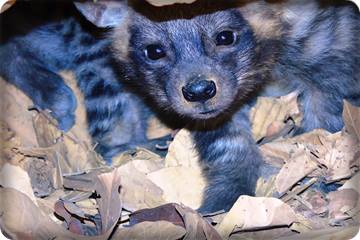
- Kingdom - Animalia
- Phylum - Chordata
- Class - Mammalia
- Order - Carnivora
- Family - Hyenidae
- Genus - Hyaena
- Species -Hyaena hyaena
- English Name: Striped Hyaena
- Scientific Name:Hyaena hyaena
- Distribution:: Native of North and East Africa, Central Asia, the Indian subcontinent, the Middle East, and the Caucas
- General Description :
Hyenas are neither members of the dog nor the cat family. They are unique, and so have their own family: Hyaenidae, which has four members: Striped hyenas, the “laughing” Spotted hyenas, Brown hyenas, and the aardwolf (which is not a wolf). The hind legs are significantly shorter than the forelimbs, thus causing the back to slope downwards.
- Size: Male: 100-115cm Female: 66-75 cm, Tail length: 31 cm
- Weight: Male: 26-41 kg, Female: 26-34 kg
- Food in Zoo: Buffalo Meat (Boneless)
- Sexual Maturity:24-36 months
- Gestation Period: 90 days
- Average Life Span: 24 years
- Legal Conservation Status :Included in Schedule III of the wildlife (Protection) Act 1972. IUCN RedList – Near Threatened
- CITES:Appendix III
- WPA 1972:Schedule I
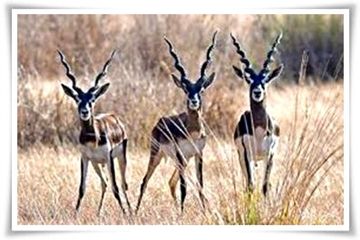

- Kingdom - Animalia
- Phylum - Chordata
- Class - Mammalia
- Order - Artiodactyla
- Family - Bovidae
- Genus - Antilope
- Species -Antilope cervicapra
- English Name: Blackbuck
- Scientific Name:Antilope cervicapra
- Distribution:The main area of their habitat is India and eastern Pakistan. They live in grassy plains and thinly forested areas where perennial water sources are available for their daily need to drink.
- General Description :
Blackbucks have slender and elegant bodies. They have pointed and delicate hooves. They possess narrow, sheep-like muzzles and short tails. Horns are found only in males. The coloration of this species depends on gender: the back, the sides, and the outer side of the legs are rich dark brown in males and yellowish in females.
- Size:120-150 cm
- Weight: Male: 34-45 kg, Female: 31-39 kg
- Food in Zoo: : Spinach, grass and leaves, soya meal, mahua, bird mesh.
- Sexual Maturity: Male: 3 years, Female: 2 years
- Gestation Period: 6 months
- Average Life Span: 15-18 years
- Legal Conservation Status : Near threatened
- CITES:Appendix III
- WPA 1972:Schedule I

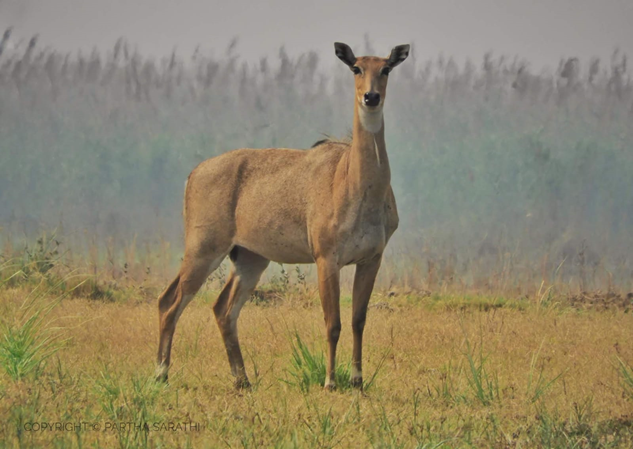
- Kingdom - Animalia
- Phylum - Chordata
- Class - Mammalia
- Order - Artiodactyla
- Family - Bovidae
- Genus - Boselaphus
- Species -Boselaphus tragocamelus
- English Name: Nilgai
- Scientific Name:Boselaphus tragocamelus
- Distribution: Boselaphus tragocamelus, also called the nilgai antelope, evolved in peninsular India during the Tertiary geological period, where they are also currently found.Today they are found on large ranches in Kenedy and Willacy counties of Texas.
- General Description :
This sturdy thin-legged antelope is characterized by a sloping back, a deep neck with a white patch on the throat, a short mane of hair behind and along the back ending behind the shoulder, and around two white spots each on its face, ears, cheeks, lips, and chin.
- Size: Body length: Male: 180-210 cm, Female: 170 cm
- Weight:Male: 200-228 kg, Female: 120-220 kg
- Food in Zoo:: Wheat bran, Maize shell, grass and leaves, mahua, bird mesh.
- Sexual Maturity: 2.2 years
- Gestation Period: 8.5 months
- Average Life Span: 21-22 years
- Legal Conservation Status :Least Concern
- CITES:Not Listed
- WPA 1972:Schedule III
- Kingdom - Animalia
- Phylum - Chordata
- Class - Mammalia
- Order - Rodentia
- Family - Hystricidae
- Genus - Hystrix
- Species -Hystrix indica
- English Name:Indian Porcupine
- Scientific Name:Hystrix indica
- Distribution: The range of Indian porcupine covers a huge territory, stretching across southeast and central Asia and some parts of the Middle East.
- General Description :
The Indian porcupine is having rather long quills of up to 16 inches. Unlike the 'New World' porcupines, this porcupine is a ground-dwelling and burrowing animal. The amazingly strong front feet allow the animal excavate substantial burrows.
- Size: Body length- 60-90cm, Tail Length: 8-10 cm
- Weight: 11-18 kg.
- Food in Zoo: Makai darra, Guava, ripe banana, cabbage
- Sexual Maturity: 24 months
- Gestation Period: 240 days
- Average Life Span: 5-10 years
- Conservation Status: Near Threatened
- CITES: : Appendix II
- WPA 1972:Schedule IV
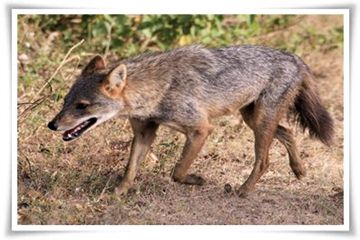
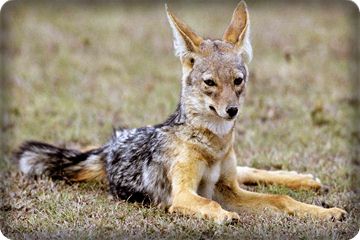
- Kingdom - Animalia
- Phylum - Chordata
- Class - Mammalia
- Order - Carnivora
- Family - Canidae
- Genus - Canis
- Species -Canis aureus
- English Name:Golden Jackal
- Scientific Name:Canis aureus
- Distribution:Golden jackals are widely distributed from North and East Africa to southeastern Europe and South Asia, including Burma.
- General Description :
The Golden jackal (Canis aureus) is a wolf-like canid. Despite its name, the Golden jackal is not closely related to the African Black-backed jackal or Side-striped jackal, which are part of the genus Lupulella, being instead closer to wolves and coyotes. Living nearby human settlements, Golden jackals are strictly nocturnal. However, those living in other areas can be partly diurnal.
- Size: Male: 76-84cm Female: 74-80cm
- Weight:Male:7.6-9.8 kg, Female:6.5-7.8 kg .
- Food in Zoo: Chicken, Buffalo meat.
- Sexual Maturity:24 months
- Gestation Period: 63 days.
- Average Life Span: 20-22 years
- Conservation Status: Least Concern
- CITES: Appendix – III
- WPA 1972:Schedule II
- Kingdom - Animalia
- Phylum - Chordata
- Class - Mammalia
- Order - Carnivora
- Family - Canidae
- Genus - Vulpes
- Species -Vulpes bengalensis
- English Name:Bengal fox
- Scientific Name:Vulpes bengalensis
- Distribution:The Bengal fox is native to the Indian subcontinent. It also inhabits the Himalayan foothills and the Terai area of Nepal through to southern India and from eastern and southern Pakistan to the east of India and southeastern Bangladesh.
- General Description :
The Indian fox, also known as the Bengal fox, is a species of Asian foxes are endemic to the Indian subcontinent.This is a medium-sized fox with an elongated muzzle with black hair in small patches on the upper part of the muzzle
- Size: Male: 39-57cm Female: 46-48 cm, Tail length: 24-30 cm
- Weight:Male:2.7-3.2 kg, Female:1.8 kg
- Food in Zoo: Chicken
- Sexual Maturity:12-24 months
- Gestation Period: 50-60 days
- Average Life Span: 10-14 years
- Conservation Status: Least Concern
- CITES: Appendix – III
- WPA 1972:Schedule II
- Kingdom - Animalia
- Phylum - Chordata
- Class - Mammalia
- Order - Carnivora
- Family - Viverridae
- Genus - Paradoxurus
- Species -Paradoxurus hermaphroditus
- English Name:: Asian Palm-civet
- Scientific Name:Paradoxurus hermaphroditus
- Distribution:The Common Palm Civet is found from the Himalayas and southern China, to the Philippines, the Malay peninsula and the Indonesian islands
- General Description :
The Asian palm civet (Paradoxurus hermaphroditus) is a viverrid native to South and Southeast Asia. In Indonesia, this animal is threatened by poaching and illegal wildlife trade and buyers use it for the increasing production of kopi luwak, also known as civet coffee.
- Size: Body length-0.4-0.7m, Tail length- 0.45m
- Weight:2-5 kg
- Food in Zoo: Ripe Banana, Apple, Chicken
- Sexual Maturity:11-12 months
- Gestation Period: 2 months
- Average Life Span: 20-22 years
- Conservation Status: Least Concern
- CITES: Appendix – II
- WPA 1972:Schedule II
- Kingdom - Animalia
- Phylum - Chordata
- Class - Mammalia
- Order - Carnivora
- Family - Canidae
- Genus - Canis
- Species -Canis lupus pallipes
- English Name:Indian wolf
- Scientific Name:Canis lupus pallipes
- Distribution:Indian wolves are found in India, Pakistan, Afghanistan, Nepal, Bhutan, Israel, Turkey, Iran, and Syria. They live in open grasslands, thorn forests, and scrublands.
- General Description :
The Indian wolf (Canis lupus pallipes) is a subspecies of Grey wolf. It travels in smaller packs and is less vocal than other variants of the Grey wolf, and has a reputation for being cunning. The Indian wolf is one of the most endangered populations of Grey wolves in the world.
- Size: Male: 100-130 cm Female: 87-117cm, Tail Length: 40-52cm
- Weight:16-60 kg
- Food in Zoo: : Buffalo meat (boneless)
- Sexual Maturity:24 months
- Gestation Period: 60-75 days
- Average Life Span: 5-13 years
- Conservation Status: Least Concern
- CITES: not known
- WPA 1972:Schedule I
- Kingdom - Animalia
- Phylum - Chordata
- Class - Mammalia
- Order - Carnivora
- Family - Felidae
- Genus - Prionailurus
- Species -Prionailurus bengalensis
- English Name:: Leopard Cat
- Scientific Name:Prionailurus bengalensis
- Distribution:The Himalayas and Terai. Eastward to the north-east and southward to the Western Ghats. Absent in the arid parts of Rajasthan, Gujarat and large part of Deccan.
- General Description :
The Leopard cat (Prionailurus bengalensis) is a small wild cat native to continental South, Southeast, and East Asia. The Leopard cat is about the size of a large housecat. The head of the animal is small, eyes are round and the muzzle is short.
- Size:Male leopard cats reach up to 0.45-0.75 metres in length.
Female reach up to 0.195-0.315 metres in length.
- Weight:3-4 kg
- Food in Zoo: Buffalo meat (boneless), Chicken
- Sexual Maturity:5 years
- Gestation Period: : 65-70 days
- Average Life Span: 15-20 years
- Conservation Status: Lower Risk
- CITES: Appendix – II
- WPA 1972:Schedule II
- Kingdom - Animalia
- Phylum - Chordata
- Class - Mammalia
- Order - Artiodactyla
- Family - Suidae
- Genus - Sus
- Species -Sus scrofa
- English Name:Wild Boar
- Scientific Name:Sus scrofa
- Distribution:Wild boars (Sus scrofa) are a cosmopolitan species. They originated in Europe and Asia, but were widely introduced to North America and are considered an invasive species in the southeastern United States and California. They are common throughout Eurasia, and inhabit every continent except Antarctica..
- General Description :
The Wild boar is a bulky, massively built suid with short and relatively thin legs. The trunk is short and robust, while the hindquarters are comparatively underdeveloped.
- Size:Body length: 153-240 cm, height: 55-100 cm
- Weight:66-272 kg
- Food in Zoo:
- Sexual Maturity:5 years
- Gestation Period: 108-120 Days
- Average Life Span: 2-27 years
- Conservation Status: Least Concern
- CITES: No special status
- WPA 1972:Schedule III
- Kingdom - Animalia
- Phylum - Chordata
- Class - Mammalia
- Order - Primates
- Family - Lorisidae
- Genus - Nycticebus
- Species -Nycticebus bengalensis
- English Name:Bengal slow loris
- Scientific Name:Nycticebus bengalensis
- Distribution:Bengal slow lorises are endemic to the forested areas of south-eastern Asia, including the seven north-eastern states of India (Assam, Arunachal Pradesh, Mizoram, Nagaland, Meghalaya, Manipur, and Tripura) as well as areas of Cambodia, Burma, Thailand, Vietnam, and southern regions of China.
- General Description :
The Bengal slow loris is the largest species of slow loris. It has dense, woolly, brown-gray fur on its back and white fur on its underside.
- Size:26-38 cm
- Weight:1-2 kg
- Food in Zoo: Ripe banana, chick
- Sexual Maturity:1-1.5 Years
- Gestation Period: 176-198 days
- Average Life Span: 15-20 years
- Conservation Status:Vulnerable
- CITES: Appendix I
- WPA 1972:Schedule I
- Kingdom - Animalia
- Phylum - Chordata
- Class - Mammalia
- Order - Rodentia
- Family - Sciuridae
- Genus - Ratufa
- Species -Ratufa indica
- English Name:Indian Giant Squirrel
- Scientific Name:Ratufa indica
- Distribution:The Indian giant squirrel is a native Indian species, where this animal occurs in the Satpura hill range of Madhya Pradesh and Maharashtra. The preferred habitat of this rodent is deciduous and most evergreen forests, found throughout peninsular India.
- General Description :
The Indian giant squirrel (Ratufa indica) is a large multi-coloured tree squirrel species. It is a diurnal, arboreal, and mainly herbivorous squirrel.
- Size:Body length: 153-240 cm, height: 55-100 cm
- Weight:2 kg
- Food in Zoo: Apple, banana, groundnut, chickpeas
- Sexual Maturity:24-36 months
- Gestation Period: 28-35 days
- Average Life Span: 20 years
- Conservation Status: Near Threatened
- CITES:Appendix II
- WPA 1972:Schedule II
<- Kingdom - Animalia
- Phylum - Chordata
- Class - Mammalia
- Order - Artiodactyla
- Family - Traguilidae
- Genus - Moschiola
- Species -Moschiola indica
- English Name:Indian spotted Chevrotian
- Scientific Name:Moschiola indica
- Distribution:Within India, the Indian chevrotain is commonly encountered in a number of forest areas along the Western Ghats, in the Eastern Ghats up to Orissa, and in the forests of central India.
- General Description :
India’s smallest deer, the Mouse deer, also known as Indian Chevrotain (Tragulus meminna), is a very timid and nocturnal animal difficult to spot in the wild.
- Size:Body length: 55-59 cm
- Weight:2-4 kg
- Food in Zoo: Makai darra, brinjal, cabbage
- Sexual Maturity:24 months
- Gestation Period: 150-160 days
- Average Life Span: 8-12 years
- Conservation Status: Least Concern
- CITES:No special status
- WPA 1972:Schedule I

